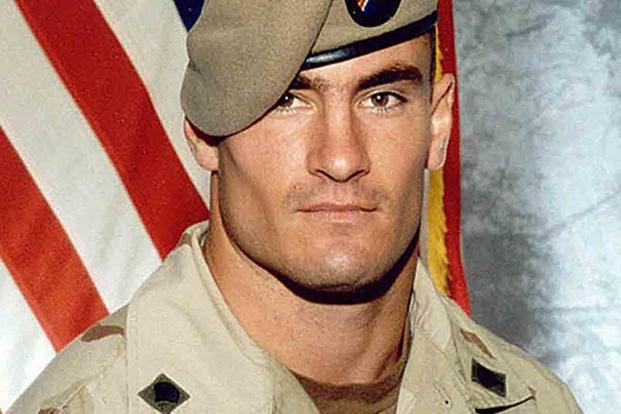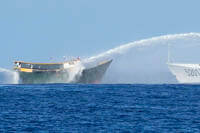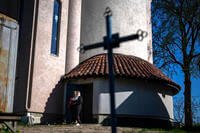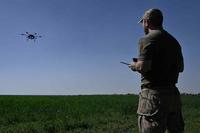Leland High led 35-0 at halftime and coach Terry Hardtke figured enough was enough.
Pat Tillman had scored four touchdowns on offense and was dominating defensively in a Central Coast Section playoff game against Andrew Hill. Hardtke told Tillman he was done for the day.
“I said, ‘No offense, no defense,'” Hardtke recalled. “He gave me this sorrowful look.”
When the second half began, to Hardtke’s surprise, Tillman was on the field to receive the kickoff. Tillman ran it back for his fifth touchdown of the game on the seventh time he touched the ball. While teammates celebrated, Tillman made a beeline for Hardtke.
“He said, ‘Coach, you said nothing about special teams,'” Hardtke said.
Hardtke confiscated Tillman’s helmet and shoulder pads. Tillman followed orders and sat out the rest of a 66-14 win en route to an eventual CCS title.
To Hardtke it was quintessential Tillman, doing everything that was asked of him and then doing even more.
“I don’t look at that as defying what I said,” Hardtke said. “I look at it as his approach to the way he lived his life and the way he played the game.”
It was 20 years ago, on April 22, 2004, that Tillman was killed at age 27 by friendly fire in a firefight in Spera, Afghanistan, as part of the U.S. Army Second Ranger Battalion. Tillman’s story, and the military cover-up that followed over the circumstances of his death, became national news.
Tillman and his younger brother Kevin enlisted after digesting the terrorist attacks on Sept. 11, 2001. Pat walked away from a $3.6 million contract as a safety for the Arizona Cardinals after starring at Arizona State.
His legacy lives on in the Pat Tillman Foundation, which has sent 871 Tillman Scholars to graduate school at a cost of more than $34 million.
The scholarship is open to military service members, veterans and spouses and is funded in part by the annual “Pat’s Run” in Tempe, Arizona, which drew more than 28,000 participants on April 13.
In Arizona alone, there are two statues of Tillman — the Pat Tillman Military Center at Arizona State and the Mike O’ Callaghan-Pat Tillman Bridge over Hoover Dam from Arizona into Las Vegas.
Tillman was born in Fremont but grew up in the Almaden Valley in San Jose. He was the first of three sons, followed by Kevin and Richard. The Leland High field now bears his name.
Ben Hill, a member of the Tillman Foundation board, was a friend since childhood and remembers Tillman’s daredevil side, the kid who loved hikes with his friends and was eager to take the dicey tree rope swing over a reservoir.
“As I look back on it, Pat was more adventurous as a way to keep him sharp and more of a risk-taker in different activities than the rest of us, which was always entertaining,” Hill said.
Tillman first starred in baseball. In the book, “Where Men Win Glory: The Odyssey of Pat Tillman,” author Jon Krakauer cited a 2002 entry from Tillman’s diary about how the sport boosted his self-esteem.
“As odd as this sounds, a diving catch I made in the 11-12 all-stars was a take-off point,” Tillman wrote. “I excelled the rest of the tournament and gained incredible confidence. It sounds tacky but it was big.”
An undersized 13-year-old freshman at Leland, Tillman had muscular forearms and calves, according to Hill, and was extremely athletic. However, Tillman gave up baseball when told he couldn’t make varsity. Hardtke, the football coach, told him he was making a mistake.
“He said, ‘Coach, I’m going to get in the weight room, I’m going to get big and strong and play Division I football,'” Hardtke said. “I told him, ‘Pat, you have a better chance at baseball than you do at football.’ See how smart I was as a coach?”
The weight room and a growth spurt in his junior year contributed to Tillman making good on his promise. In his senior year, Tillman had 31 touchdowns rushing, receiving and returning, plus 110 tackles, three interceptions and 10 sacks on defense to lead the Chargers to the CCS title.
Raised to be respectful, keep his promises and stand up for the vulnerable, Tillman was an excellent student and had his heart set on a Stanford scholarship.
Bill Walsh, in his second stint at Stanford, told Hardtke that Tillman wasn’t big or fast enough.
“Arizona State wound up giving him their last scholarship when someone else backed out,” Hardtke recalled.
(Walsh, according to Hardtke, apologized for his mistake at Tillman’s San Jose memorial).
During his senior year, Tillman, coming to the aid of a friend at a fight in a parking lot outside a pizza parlor, beat up another student, sending him to the hospital. Prosecutors considered felony assault with jail time, which would have meant the loss of the Arizona State scholarship. He ended up being charged with misdemeanor assault and served 30 days in a youth facility and 250 hours of community service.
Although the incident was sealed because of his age, Tillman later told a Sports Illustrated writer about it and said he “learned more from jail than all the good decisions I ever made.”
At Arizona State, Tillman befriended Doug Tammaro, who was in his second year with the sports information department.
“He had long hair, he was goofy, he was loud,” Tammaro said. “He was more outgoing than most, but he wasn’t brazen. He was always respectful and got along with everybody.”
Once at football study hall, Tillman wasn’t particularly engaged and was confronted about it by an academic coach. Tillman, according to Tammaro, responded that he didn’t really need to be there since his grade point average was 3.9.
“As the story goes, she told him, ‘Well, these guys need to see you here,'” Tammaro said. “From that point on, he was fine. He knew other people were looking at him and he had an example to set.”
After a career that included a Pac-12 Defensive Player of the Year award and ASU’s second-ever Rose Bowl berth, Tillman faced the same skepticism about his ability in the NFL Draft as he did coming out of Leland. He lasted until the seventh round before being taken by the Arizona Cardinals.
Tillman became a standout safety, playing from 1998 through 2001. His decision to enlist in the Army and join the Rangers elite fighting force along with his brother Kevin after the 9/11 attacks surprised friends and family, although they weren’t shocked.
Tillman alerted his inner circle before news broke and urged them to keep their feelings private. He gave no interviews and recoiled at the thought of personal hyperbole, resisting efforts to be used as a recruiting tool.
Alex Garwood was in college at Cal Poly-San Luis Obispo when he met Tillman as a 17-year-old senior-to-be. He would become Tillman’s brother-in-law, as his spouse was the sister of Pat’s wife Marie. They went on runs together, and it was on one of those runs that Tillman told Garwood of his reasons for enlisting.
“By the time we got to the bottom of the hill,” Garwood said, “he had answered every question, and it was clear he and his wife had thought it out.”
Garwood, a Tillman Foundation board member who has spoken for the family in the past, still remembers the intersection he was at while driving two years later when his mother-in-law called him on his car phone and hysterically gave him the news.
Hill was with his wife en route to Southern California when he got word. His voice cracked at the memory of turning around and heading for Tillman’s parents’ home in the Almaden Valley.
“It still hurts. Mama T and Papa T let us gather in their front yard and hang out, making banners for when Kevin came back,” Hill said.
Hardtke came to the house with Ronnie Lott, the 49ers safety who inspired Tillman to wear No. 42 in high school and college.
Tillman has impacted the lives of people he never met. Adam Garwood, Alex’s son, was an infant when his uncle passed away, and wore No. 42 in his honor at Los Gatos High and Cal Poly.
“There’s not a family gathering that goes by when we’re together and not talking about him,” Adam Garwood said. “I think about him every day.”
Then there’s Jack Cummings, an East Coast native with no ties to Tillman or Arizona State who named his son “Tillman” because he was so impacted by the news. Cummings lived across the street in Manhattan Beach from a college friend of Tammaro, a random connection that led to Cummings and his son participating in Pat’s Run in Tempe on several occasions.
Cummings’ father was in the military, and when he learned of the news of Tillman’s death, began to ponder naming his son — due that July — after a man he’d never met.
“I hoped that when he told someone his name, maybe it would remind people of Pat,” Cummings said. “I remember saying to my wife, ‘I don’t ask for much, but this is non-negotiable.'”
Tillman Cummings is now a 20-year-old junior at Alabama. Tammaro, who along with Alex Garwood helped start Pat’s Run and the foundation, said he hears each year at the run — the “state’s greatest day” — about children named Patrick in honor of Tillman.
Tammaro may have been one of the last non-family members to talk to Tillman, at a dinner in Seattle. Pat was stationed nearby, waiting to be deployed, when he met Tammaro along with Kevin and Marie.
“There were all these windows, and one of them looked like a door, and he couldn’t get in,” Tammaro said. “I told him, ‘I’m glad to know our national security is in the hands of someone who can’t open a door.’ He started to laugh, and we talked for four hours.”
For all the good done by the Tillman Foundation, Alex Garwood thinks of how it could have been better.
“I feel Pat could have, should have, would have done more,” Garwood said. “Yes, we’re accomplishing stuff in his name, and it’s incredible. But wouldn’t it be much better to see what Pat would have done?”
©2024 MediaNews Group, Inc. Visit at mercurynews.com. Distributed by Tribune Content Agency, LLC.











